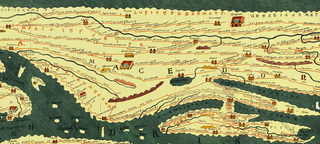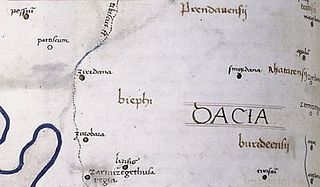Related Research Articles

Dacia was the land inhabited by the Dacians. The Greeks referred to them as the Getae and the Romans called them Daci.

The Dacians were the ancient Indo-European inhabitants of the cultural region of Dacia, located in the area near the Carpathian Mountains and west of the Black Sea. They are often considered a subgroup of the Thracians. This area includes mainly the present-day countries of Romania and Moldova, as well as parts of Ukraine, Eastern Serbia, Northern Bulgaria, Slovakia, Hungary and Southern Poland. The Dacians and the related Getae spoke the Dacian language, which has a debated relationship with the neighbouring Thracian language and may be a subgroup of it. Dacians were somewhat culturally influenced by the neighbouring Scythians and by the Celtic invaders of the 4th century BC.

Dacian is an extinct language, generally believed to be Indo-European, that was spoken in the Carpathian region in antiquity. In the 1st century, it was probably the predominant language of the ancient regions of Dacia and Moesia and possibly of some surrounding regions. The language was extinct by the 4th century AD.

Motru is a city in Romania, Gorj County. It is situated on the river Motru in western Oltenia. The county capital Târgu Jiu is located about 35 km northeast. The city administers eight villages: Dealu Pomilor, Horăști, Însurăței, Leurda, Lupoița, Ploștina, Roșiuța and Râpa.

Argedava was an important Dacian town mentioned in the Decree of Dionysopolis (48 BC), and potentially located at Popești, a district in the town of Mihăilești, Giurgiu County, Muntenia, Romania.

The Motru is a right tributary of the river Jiu in Southwestern Romania. It discharges into the Jiu in Gura Motrului, near the town Filiași. Its length is 134 km (83 mi) and its hydrological basin size is 1,895 km2 (732 sq mi).

The Anartes were Celtic tribes, or, in the case of those sub-groups of Anartes which penetrated the ancient region of Dacia, Celts culturally assimilated by the Dacians.

Argidava was a Dacian fortress town close to the Danube, inhabited and governed by the Albocense. Located in today's Vărădia, Caraș-Severin County, Romania.

Aizis was a Dacian town mentioned by Emperor Trajan in his work Dacica. Located at Dealul Ruieni, Fârliug, Caraș-Severin, Banat, Romania.

Zurobara was a Dacian town located in today's Banat region in Romania. It is positioned by the Tibiscus river, north of Zarmizegethusa Regia and south of Ziridava. It was near the Tisza river, in the area of the Dacian tribe of Biephi.
The Decree of Dionysopolis was written around 48 BC by the citizens of Dionysopolis to Akornion, who traveled far away in a diplomatic mission to meet somebody's farther in Argedauon. The decree, a fragmentary marble inscription, is located in the National Historical Museum in Sofia.

Amutria was a Dacian town close to the Danube and included in the Roman road network, after the conquest of Dacia.
Pelendava was a Dacian town.
Rusidava was a Dacian town mentioned in Tabula Peutingeriana between Acidava and Pons Aluti, today's Drăgășani, Vâlcea County, Romania.

Tibiscum was a Dacian town mentioned by Ptolemy, later a Roman castra and municipium. The ruins of the ancient settlement are located in Jupa, Caraș-Severin County, Romania.

Şanţul Mare is an important archaeological site located 9 km west of Pecica, Arad County, Romania, near the border with Semlac commune and 600 m from the river Mureș.

Ziridava was a Dacian town located between Apulon and Tibiscum, mentioned by Ptolemy in the area of the Dacian tribe of Biephi.

Potaissa was a castra in the Roman province of Dacia, located in today's Turda, Romania.
References
Ancient
- Ptolemy, Claudius (c. 140). Geographia [Geography] (in Ancient Greek). Sumptibus et typis Caroli Tauchnitii.
Modern
- Pârvan, Vasile (1926). Getica (in Romanian). București, Romania: Cvltvra Națională.
- Dobiáš, Josef (1964). Dějiny československého území před vystoupením Slovanů. Nakl. Československé akademie věd.
- Schütte, Gudmund (1952) [1952]. "A Ptolemaic Riddle Solved p. 236". Classica et Mediaevalia, Volume 13. Vol. 13 (1 ed.). Gyldendal.
- Schütte, Gudmund (1917). Ptolemy's maps of northern Europe: a reconstruction of the prototypes. Copenhagen: H. Hagerup.
- Šimek, Emanuel (1953). Velká Germanie Klaudia Ptolemaia. Nákladem filosofické fakulty university Karlovy.
